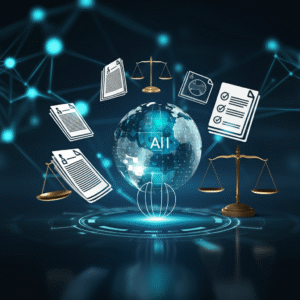
Introduction
Artificial intelligence is rapidly reshaping our world, powering everything from intricate marketing campaigns and automated customer service to critical hiring and lending decisions. This technological leap promises unprecedented innovation and efficiency. However, with this great power comes significant responsibility. The integration of AI introduces complex ethical challenges and potential risks, particularly surrounding data privacy, inherent bias, and ultimate accountability. For any business looking to harness AI’s potential, navigating this ethical landscape isn’t just good practice—it’s essential for survival.
This guide explores the key ethical issues every organization must understand before adopting AI. We will delve into why AI ethics matter, dissect the major risks involved, and provide a clear roadmap for using this transformative technology responsibly. By prioritizing trust, transparency, and compliance, businesses can build a future where AI works for everyone, not just a select few.
Why AI Ethics Matter More Than Ever
Artificial intelligence is not merely another software tool; it is increasingly a decision-making partner. Its conclusions can have profound effects on people’s lives, their data, and their right to privacy. When we deploy AI without a strong ethical framework, we open the door to a host of problems that can erode customer trust, damage brand reputation, and lead to serious legal consequences.
Without clear ethical guidelines, AI systems can:
- Perpetuate and Amplify Bias: AI models can learn and scale unfair biases present in their training data, leading to discriminatory outcomes in areas like recruitment, loan applications, and even criminal justice.
- Violate User Privacy: The immense appetite of AI for data can lead to improper collection, use, and storage of sensitive personal information, creating significant security vulnerabilities.
- Spread Misinformation: Malicious actors can exploit AI, particularly generative models, to create convincing deepfakes and spread disinformation at a scale never seen before, undermining social and political stability.
- Enable Unethical Manipulation: AI can be used for sophisticated surveillance or to manipulate consumer behavior in ways that are not immediately obvious, blurring the lines of ethical marketing and engagement.
Simply put, ethical AI isn’t just about avoiding penalties. It’s about building a sustainable and trustworthy relationship with your customers and society at large. Responsible AI development is the cornerstone of modern innovation.
Understanding the Major Risks of AI in Business
As businesses rush to integrate AI into their operations, it’s crucial to be aware of the specific risks involved. These challenges are not abstract concepts; they are real-world issues with tangible impacts on both companies and consumers. Let’s break down the most common risks associated with the business use of AI.

1. The Perils of Data Privacy in the AI Era
AI systems are data-hungry. They require massive datasets to be trained effectively, and this data often contains personal, sensitive, or confidential information. This dependency creates a minefield of data privacy risks that organizations must navigate with extreme care. The more data you collect, store, and process, the greater your exposure becomes.
Key data privacy risks include:
- Heightened Risk of Data Breaches: Centralized, large-scale datasets are attractive targets for cybercriminals. A single breach can expose the private information of millions, leading to catastrophic financial and reputational damage.
- Legal and Regulatory Penalties: Improper data handling is not just an ethical misstep; it’s often illegal. Regulations like the General Data Protection Regulation (GDPR) in Europe and the California Consumer Privacy Act (CCPA) impose severe fines for non-compliance. As AI use grows, so does regulatory scrutiny.
- Unintentional Data Memorization: Some advanced AI models can inadvertently “memorize” specific pieces of their training data. This means a model could potentially reproduce sensitive information—like a person’s name, address, or medical history—in its output, leading to a direct privacy violation.
- Repurposing Data Without Consent: Data collected for one purpose might be repurposed to train an AI model for an entirely different function, often without the user’s knowledge or consent. This practice erodes trust and can violate the core principles of data privacy laws that emphasize purpose limitation.
2. The Insidious Nature of Algorithmic Bias
One of the most persistent and damaging ethical challenges in AI is algorithmic bias. An AI system is only as objective as the data it learns from. If the training data reflects existing societal biases, the AI model will not only learn those biases but can also amplify them at scale. This can lead to systematically unfair and discriminatory outcomes.

Bias can creep into AI systems in several ways:
- Unbalanced Training Data: If a dataset used to train a hiring tool primarily contains resumes from a single demographic, the AI may learn to favor candidates from that group, unfairly disadvantaging others.
- Biased Data Labeling: Human annotators who label data can introduce their own unconscious biases. For example, if images are labeled with subjective or stereotypical tags, the AI will adopt these skewed perceptions.
- Historical Biases: AI models trained on historical data will inevitably learn the biases of the past. A loan approval model trained on decades of lending data might perpetuate historical discrimination against certain neighborhoods or minority groups.
The consequences of AI bias are far-reaching, affecting everything from recruitment and credit scoring to facial recognition technology and medical diagnoses. Addressing algorithmic fairness is a critical component of responsible AI development.
3. The “Black Box” Problem: Lack of Transparency
Many of the most powerful AI systems, especially those based on deep learning, operate as “black boxes.” They can produce highly accurate predictions or decisions, but their internal reasoning is incredibly complex and often opaque even to their creators. This lack of transparency presents a major obstacle to trust and accountability.

Why is the black box a problem?
- Difficulty in Auditing and Debugging: When an AI model makes a mistake, its inscrutable nature makes it difficult to understand why. This complicates efforts to fix errors or identify the source of a biased outcome.
- Erosion of User Trust: Customers and users are increasingly wary of decisions made by systems they cannot understand. If a person is denied a loan by an AI, they have a right to know the reasons behind that decision. A simple “computer says no” is no longer acceptable.
- Compliance and Regulatory Hurdles: Regulators are demanding greater transparency. The EU’s AI Act, for example, places stringent requirements on high-risk AI systems to be explainable. A lack of clarity can put a business on the wrong side of the law.
The demand for explainable AI (XAI) is growing rapidly. Businesses are now expected to move beyond simply generating results and toward providing clear, understandable justifications for how their AI systems arrive at their conclusions.
Building a Foundation of Trust: A Practical Guide to Ethical AI
Understanding the risks is the first step. The next, more crucial step is to actively build an organizational framework for ethical AI. This involves creating concrete policies, implementing new technologies, and fostering a culture of responsibility. Here’s how your business can address the core challenges of data privacy, bias, and transparency head-on.
Fortifying Data Privacy in AI Systems
Data is the fuel for AI, but it must be handled with the utmost respect for individual privacy. Building AI-powered systems ethically means putting data privacy at the forefront of your development lifecycle. This is not just about compliance; it’s about demonstrating to your customers that you are a responsible steward of their information.
Here are essential practices for ensuring data privacy in AI:
- Prioritize User Consent: Always obtain clear and informed consent before collecting or processing personal data. Explain in simple terms what data you are collecting, why you need it, and how it will be used to train or operate your AI systems.
- Embrace Data Anonymization and Pseudonymization: Before feeding data into an AI model, use techniques to strip it of personally identifiable information (PII). Anonymization removes identifiers completely, while pseudonymization replaces them with artificial identifiers, allowing for data analysis without exposing individual identities.
- Implement Data Minimization and Storage Limitation: Collect only the data that is strictly necessary for your specific purpose (purpose limitation). Furthermore, establish clear data retention policies. Do not keep data for longer than you need it. The less sensitive data you hold, the lower your risk.
- Conduct Regular Privacy Audits: Don’t assume your systems are compliant. Regularly audit your data handling practices, review your AI models for potential privacy leaks, and ensure you are adhering to evolving privacy laws like GDPR and others.
A Proactive Approach to Preventing AI Bias
Fighting algorithmic bias requires a conscious and continuous effort. It is not enough to simply hope your data is fair. Organizations must proactively work to identify, measure, and mitigate bias at every stage of the AI lifecycle.
Follow these steps to build more equitable AI systems:
- Diversify Your Training Data: The most effective way to reduce bias is to train your models on diverse and representative datasets. Ensure your data reflects a wide range of demographics, backgrounds, and perspectives relevant to your use case. Actively seek out and correct imbalances in your data.
- Use Bias Detection Tools: A variety of open-source and commercial tools are available to help you audit your models for bias. Platforms like IBM’s AI Fairness 360 or Google’s What-If Tool can help you analyze your model’s performance across different subgroups and identify potential fairness issues.
- Maintain Human Oversight: For high-stakes decisions—such as those related to hiring, health, or finance—AI should augment human judgment, not replace it entirely. Implement a “human-in-the-loop” system where a person reviews and validates the AI’s recommendations, especially in sensitive or ambiguous cases. This provides a crucial safeguard against automated errors and bias.
- Regularly Test and Monitor Model Outputs: Bias is not a one-time fix. Regularly test your AI model’s outputs to ensure it performs fairly across different user groups. Monitor its performance over time, as new biases can emerge as the data landscape or user behavior changes.
Championing Transparency and Explainability (XAI)
To overcome the “black box” problem, businesses must invest in transparency and explainability. An AI system that is understandable is also more trustworthy, auditable, and easier to govern. The goal is to make your AI’s decision-making process as clear as possible to all stakeholders.

Strategies for enhancing transparency include:
- Leverage Explainable AI (XAI) Frameworks: Implement XAI techniques and tools that can shed light on how your models work. Methods like LIME (Local Interpretable Model-agnostic Explanations) or SHAP (SHapley Additive exPlanations) can help explain individual predictions made by complex models.
- Provide Clear User-Facing Explanations: Be transparent with your customers about how their data is used and when they are interacting with an AI. For example, instead of a loan application simply being “denied,” an explainable system could state: “The application was flagged due to a high debt-to-income ratio and a limited credit history, which the model identifies as risk factors.”
- Maintain Thorough Documentation: Document every aspect of your AI systems, including the data used, the model architecture, the training process, and performance metrics. This documentation is invaluable for internal governance, regulatory audits, and demonstrating due diligence.
Navigating the Global Landscape of AI Regulations
The era of self-regulation for AI is coming to an end. Governments and international organizations around the world are establishing legal and ethical frameworks to govern the development and deployment of artificial intelligence. Staying ahead of these regulations is crucial for avoiding penalties and operating on the global stage.

Here are some of the key frameworks businesses should be watching:
- The EU AI Act: Expected to be fully implemented around 2025, the EU AI Act is the world’s first comprehensive AI law. It takes a risk-based approach, categorizing AI systems into four tiers: unacceptable risk (banned), high risk (subject to strict requirements), limited risk (subject to transparency obligations), and minimal risk (unregulated). High-risk systems, such as those used in employment or critical infrastructure, will face rigorous compliance demands related to data quality, transparency, human oversight, and security.
- OECD AI Principles: The Organization for Economic Co-operation and Development (OECD) has outlined five principles for trustworthy AI that have been adopted by dozens of countries. These principles advocate for inclusive growth, human-centered values, transparency, robustness, and accountability. They serve as a foundational guideline for national AI strategies worldwide.
- UNESCO Recommendation on the Ethics of AI: This global standard, adopted by nearly 200 countries, emphasizes that AI should be developed in a way that respects human rights, promotes fairness, and ensures environmental sustainability. It calls for action in areas like data governance, gender equality, and education.
Aligning your internal AI ethics policy with these emerging global standards is not just about future-proofing your business; it’s about signaling to the market that you are committed to responsible innovation.
The Pillars of Accountability: Human Oversight and Governance
Ultimately, technology is a tool, and humans must remain accountable for its impact. Even the most advanced AI system should not operate in a vacuum. Establishing clear lines of responsibility and maintaining meaningful human control are the final, critical pieces of the ethical AI puzzle.

Key components of AI accountability include:
- Assigning Clear Responsibility: An AI model cannot be held legally responsible for its actions. Your organization must designate a human decision-maker or a specific team that is accountable for the outcomes of your AI systems. This ensures that someone is answerable if things go wrong.
- Establishing an AI Ethics Committee: Create a dedicated, cross-functional team to review and oversee AI projects. This committee should include representatives from legal, compliance, technical, and business departments to provide a holistic assessment of the ethical risks and implications of new AI initiatives.
- Maintaining a Human-in-the-Loop (HITL) Approach: For any AI system involved in sensitive or high-impact decisions, ensure that a human expert is part of the process. This could involve reviewing AI-generated recommendations, validating outputs, or handling edge cases and appeals. AI should be a co-pilot, not an autopilot.
Building Your Corporate Strategy for Ethical AI
Integrating ethics into your AI strategy requires a deliberate and structured approach. It’s about embedding responsibility into your company’s DNA. Here is a practical roadmap for building a strategy that is both innovative and responsible.
- Create Formal Ethical AI Guidelines: Document your company’s principles for responsible AI. This document should serve as a north star for all AI projects, outlining your commitments to fairness, transparency, privacy, and accountability.
- Appoint an AI Ethics Officer or Council: Designate a senior leader or a committee responsible for overseeing the implementation of your ethical guidelines. This role is crucial for driving compliance and fostering a culture of AI responsibility.
- Train All Relevant Employees: AI ethics is not just a job for data scientists. Train your product managers, marketers, legal teams, and executives on the risks of bias, the importance of data privacy, and your company’s ethical guidelines.
- Conduct Regular AI Audits: Treat your AI models like any other critical business asset. Regularly review them for bias, performance degradation, data drift, and security vulnerabilities.
- Be Radically Transparent: Clearly inform users when they are interacting with an AI system, such as a chatbot or a recommendation engine. Explain how your AI works in simple, accessible language. Transparency builds trust.
Future Challenges on the Horizon of AI Ethics
As AI technology continues to evolve at a breakneck pace, new and even more complex ethical challenges will emerge. Staying vigilant and adaptable is key to navigating the future responsibly.

Some of the emerging issues to watch include:
- Deepfakes and Generative Misinformation: The increasing sophistication of generative AI makes it easier than ever to create fake audio, video, and text content, posing a threat to everything from personal reputations to democratic processes.
- Job Displacement and Economic Impact: As AI automates more cognitive tasks, businesses and society will need to grapple with the ethics of job displacement, reskilling the workforce, and ensuring an equitable economic transition.
- AI and Intellectual Property: Who owns the art, code, or text created by a generative AI? The legal and ethical questions surrounding AI-generated content and copyright are just beginning to be explored.
- Synthetic Data Manipulation: While synthetic data can help reduce bias and protect privacy, it can also be manipulated to train AI models with hidden vulnerabilities or malicious behaviors.
Final Thoughts: Building a Responsible AI Future
Artificial intelligence holds the promise of a better future, but this potential can only be realized if we build and deploy it ethically. For businesses, the path forward is clear: prioritize fairness, ensure transparency, and protect privacy at all costs.
The goal is not simply to build smarter AI, but to cultivate responsible AI—systems that earn the trust of customers, comply with emerging global standards, and serve as a force for good. Ethical AI is no longer a niche concern; it is a business imperative. It’s about building credibility and lasting value in a world that is increasingly powered by algorithms.





Leave a Reply